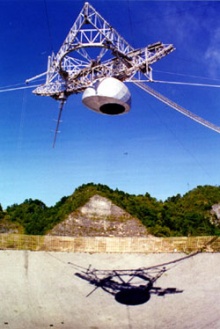SETI@home 的故事
The Story of SETI@home SETI@home 的故事
<资料出处:The Planetary Society>
In surveying the skies in search of a signal from an alien civilization, the various SETI programs have been very successful in collecting massive amounts of radio data. But collecting radio signals from space is not enough: one must still sift through the billions of channels surveyed, and differentiate between man-made interference, naturally occurring signals, and "The Real Thing". This requires massive amounts of time on the world's largest and fastest computers. Sadly, these kinds of resources are rarely available to SETI researchers, and processing the signals has become a bottleneck in the search.
为了从太空搜索到外星文明的信号,各个SETI计划已经非常成功的收集到大陆的无线电数据。但仅是从太空收集无线电信号是不够的:首先必须从数十亿频道中分析刷选,区分开人为干扰、自然发生的信号,和“真正想要的东西”。这需要到世界上最大最快的计算机大量的时间进行分析。可悲的,这种资源极难提供给SETI的研究者。因此,信号的处理已经成为了所有计划的瓶颈。
In 1994, David Gedye and Craig Kasnoff, two computer scientists from Seattle, came up with a brilliant solution to this problem: instead of running a single large computer for a long time, why not run thousands of small computers for short periods of time? This could be done, they reasoned, by having people from around the world download a simple data-processing program on their personal computers. The program would not interfere with the regular operation of the computer and would only run during its idle time. Once a batch of data was processed, the computer would return it and receive a new batch to process in its place.
在1994年,来自西雅图的两位计算机科学家 David Gedye 和 Craig Kasnoff,他们为此想出了一个杰出的解决办法:取代追求单一巨型计算机的长时间运作,将工作分配到数以千计的小型计算机以短时间进行运作。他们认为这样做是可行的。通过世界各地的人们下载一个简单的数据处理程序到他们的个人计算机,该程序不会干预计算机的正常运作,并会只在计算机闲置期间运行。当一批数据已完成分析,计算机将把结果返回并接收新的一批数据继续进行处理。

阿雷西博望远镜的天线平台 The antenna platform at Arecibo, 150 meters (500 feet) above the 300 meter (1000 foot) dish, showing the "Gregorian Dome" at the center. The SETI@home receiver is at the base of the needle-shaped line feed antenna to the left. Credit: Arecibo Observatory
这个天线平台在阿雷西博望远镜的直径300米的圆盘的“格列高里圆顶”正中以上150mi高处。SETI@home的接收器在针型天线的左侧。
It took five more years and a founding contribution by The Planetary Society to turn this idea into a reality, but in May 1999, SETI@home went online. Its success was immediate and overwhelming. Whereas the founders envisioned tens of thousands of users, or several hundred thousand at the most, SETI@home's popularity skyrocketed and quickly reached into the millions. Today, more than five million users have downloaded the program onto their personal computers! This makes SETI@home easily the world's largest supercomputer.
行星协会花了5年时间去把它这个想法变成现实,到了1999年5月,SETI@home 终于上线了,它的成功是瞬时的和压倒性的,而创始人最初仅预期数以万计,或最多数十万的用户,但SETI@home 人气爆满,很快的就达到了百万用户。今天,超过500万用户已经下载了这个程序到他们的计算机上!这使得SETI@home轻易的成为了地球上最大的超级计算机。
SETI@home is currently transitioning from its traditional “stand alone” format to being part of the BOINC family of distributed computing projects. BOINC, which stands for Berkeley Online Infrastructure for Network Computing, was developed by SETI@home Project Director David Anderson to build on SETI@home’s remarkable success. In essence, BOINC is a computing platform that makes it easy for any interested group of scientists to launch a distributed computing project. Although the venture is new, numerous scientific projects have already taken advantage of the enormous potential of BOINC. What began as a search for intelligent beings in the universe, now enables computer users around the world to take part in research on topics from gravitational waves to climate change.
SETI@home 目前已从传统的“独立”的运行模式转变为 BOINC 分布式计算项目家族中的一员。BOINC 是基于伯克利分校的在线网络计算的基础设施。它是由 SETI@home 的项目主任 David Anderson 开发的。本质上,BOINC 是一个计算平台,让任何有兴趣的科学团队推出分布式计算项目。虽然是新的冒险,但很多科学项目已经利用到了 BOINC 的巨大潜力。正如在宇宙中搜索地外文明作为一个开始,现在可以让世界各地的计算机用户参与到引力波搜索到气候变化的研究等课题中去。